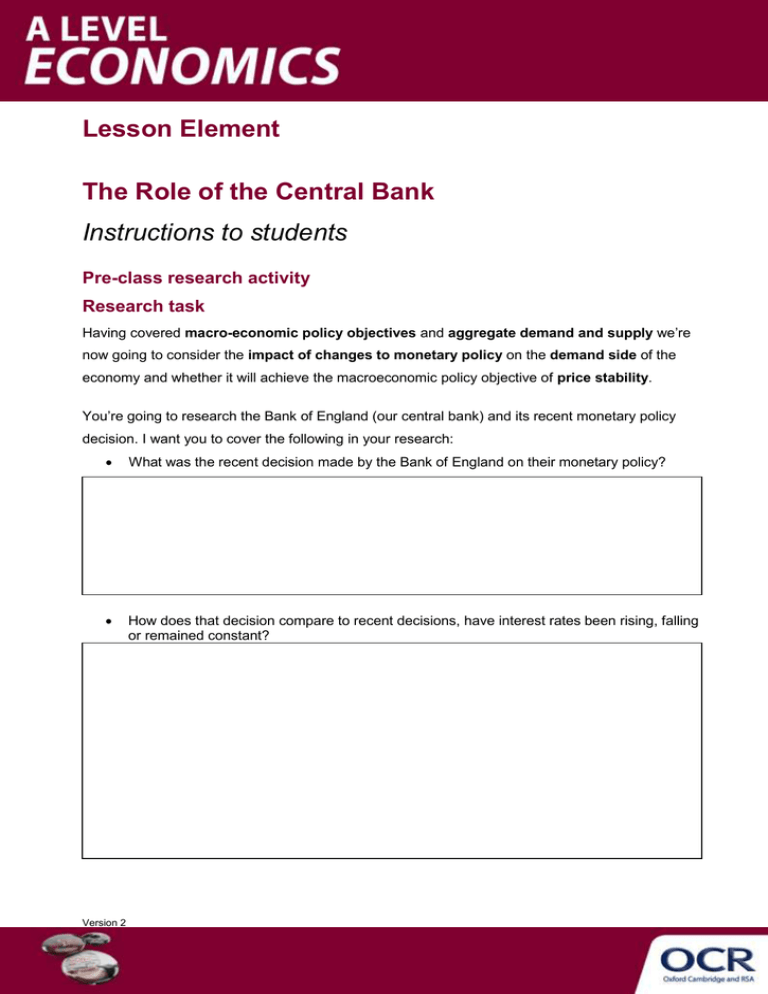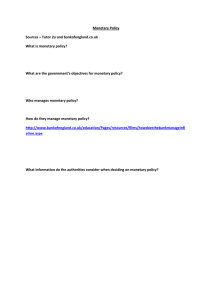The role of the central bank - Activity - Lesson element (DOCX, 155KB)
advertisement

Lesson Element The Role of the Central Bank Instructions to students Pre-class research activity Research task Having covered macro-economic policy objectives and aggregate demand and supply we’re now going to consider the impact of changes to monetary policy on the demand side of the economy and whether it will achieve the macroeconomic policy objective of price stability. You’re going to research the Bank of England (our central bank) and its recent monetary policy decision. I want you to cover the following in your research: What was the recent decision made by the Bank of England on their monetary policy? How does that decision compare to recent decisions, have interest rates been rising, falling or remained constant? Version 2 What is the role of the monetary policy framework and the objective for the Monetary Policy Committee? How does the Monetary Policy Committee make its policy decisions? Monetary policy and how, through the transmission mechanism, the rate of interest (the BASE RATE) influences aggregate demand and inflation What is the current rate of inflation and how does it compare to the policy objective of price stability? Version 2 How has the rate of inflation performed over recent years? What key factors have influenced the rate of inflation in recent years and what does the Bank expect to happen in the near future? Find out about the recent levels of economic activity in the UK: business and consumer confidence, consumer spending and investment, trade deficit, housing market, commodity prices such as food and energy. Listen to the following video clips on Quantitative Easing and write down the advantages and disadvantages of quantitative easing. Come with this research to the next lesson! Version 2 Use the web links below for your research: YouTube: http://www.youtube.com/watch?v=O7h6PM7i8PQ&feature=player_embedded BBC http://www.bbc.co.uk/news/business-15492115 Bank of England: http://www.bankofengland.co.uk/monetarypolicy/Pages/framework/framework.aspx The page covers the role of the Monetary Policy Committee, the objectives it has and how it communicates this information. There are links to three useful pdf documents at the bottom of the page. These give greater detail to the way in which decisions are made. http://www.bankofengland.co.uk/monetarypolicy/Pages/how.aspx The page covers information on how monetary policy decisions affect the rate of inflation and achieve the Bank of England’s objective. http://www.bankofengland.co.uk/publications/Pages/inflationreport/default.aspx This page holds historic inflation reports and links to webcasts of past press conferences post MPC decisions. http://www.bankofengland.co.uk/monetarypolicy/Pages/decisions.aspx The page covers information on past decisions to give students an idea of how the current rate of interest decision fits with past decisions. http://www.bankofengland.co.uk/monetarypolicy/Pages/forwardguidance.aspx This is a new page covering the basics of forward guidance. Both links (the first is a brief lecture by John Kay and the second a summary by Stephanie Flanders) consider the basics of quantitative easing and the impact it may have upon the economy. Use this to discuss the reasons for using forward guidance and the benefit of this for the macro-economic performance of the UK economy. David Smith’s blog http://www.economicsuk.com/blog/001913.html. Use the BBC website (www.bbc.co.uk) and the guardian (www.guardian.co.uk) to find out about recent events in the UK economy and the macro-economic performance in terms of the main policy objectives: economic growth, unemployment, inflation rate and balance of payments. You might also want to research consumer and business confidence and levels of investment and consumption/savings. Version 2









